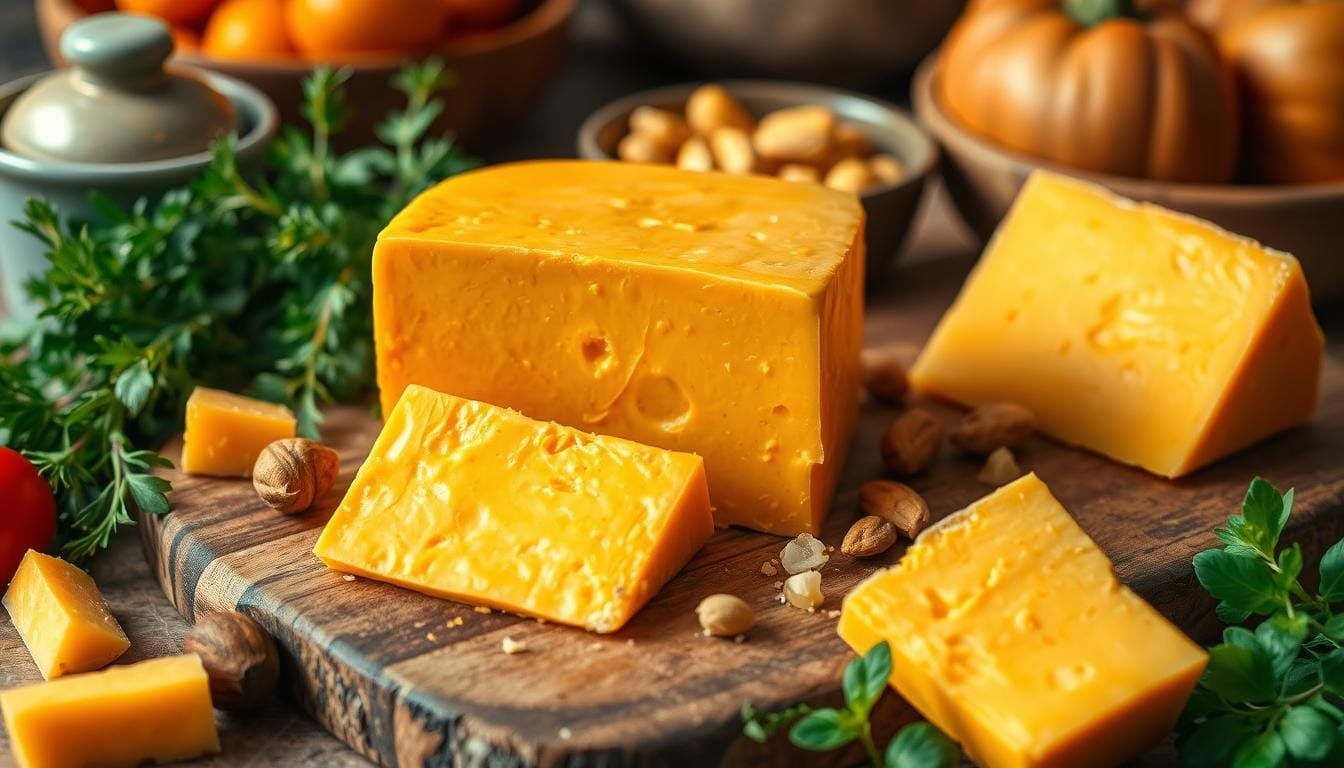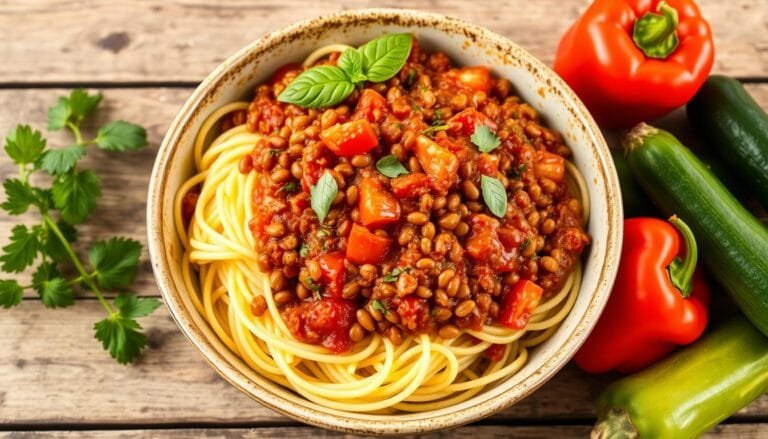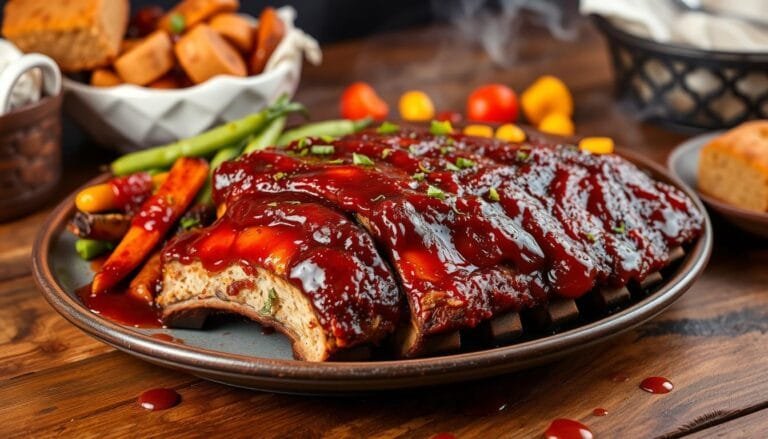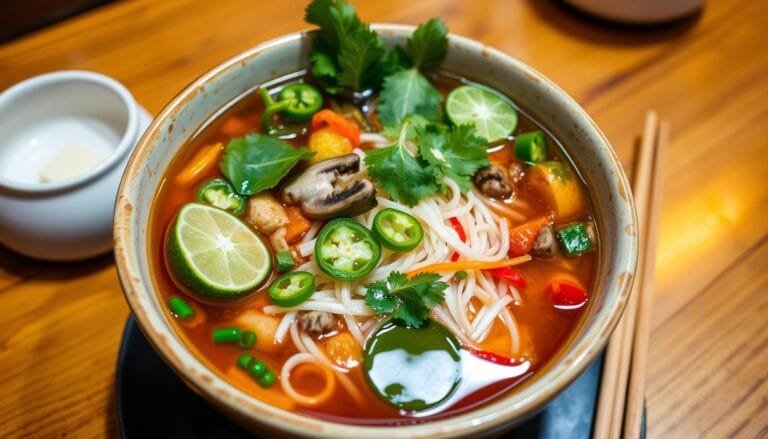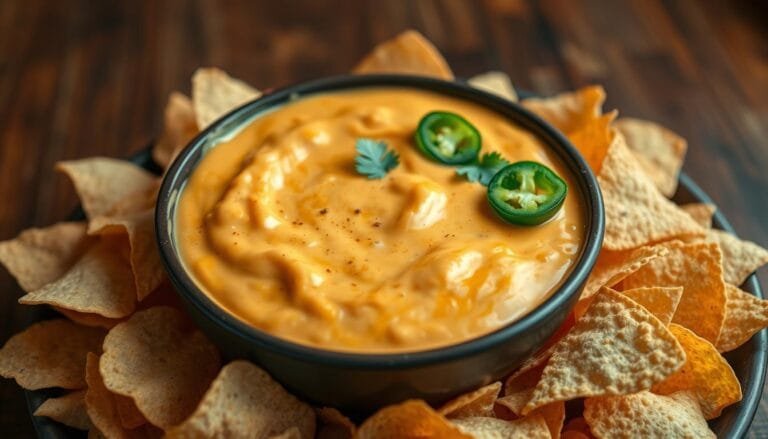I’ve always wanted a dairy-free cheese that tastes as good as the real thing. After many tries, I’m excited to share my plant-based cheddar cheese recipe. It’s creamy, tangy, and ready in just 30 minutes. It’s great for snacking, sandwiches, and cheese boards, and it’s easy on your wallet.
This vegan cheddar cheese is firm and sliceable. You can freeze it for extra firmness or keep it in the fridge for the perfect snack. With a 4.66 out of 5 rating from 20 reviews and 126 Facebook shares, it’s a hit with many.
Why This Vegan Cheddar Cheese Will Become Your New Favorite
Looking for a tasty vegan cheddar cheese? You’re in for a treat. This homemade version is not only delicious but also has many benefits.
Perfect Texture and Consistency
This vegan cheddar cheese has a crumbly yet spreadable texture. It’s just right, not too soft or too firm. It’s perfect for sandwiches and snacks.
Budget-Friendly Alternative
This homemade dairy-free cheddar alternative is cheaper than store-bought vegan cheese. It only needs 9 simple ingredients. You can make it fast and save money, always having cheese ready.
Customizable Flavoring Options
This vegan cheddar cheese is versatile. You can change the flavors to your liking. Add smoky paprika, tangy lemon, or any spice. You can make it exactly how you want it.
“This vegan cheddar cheese is a game-changer. It has the perfect texture and flavor, and I love that I can make it at home for a fraction of the cost of store-bought options.”
– Nora Taylor, recipe author
Essential Ingredients for Your Dairy-Free Cheese
Making your own vegan cheddar cheese at home is simple. You just need the right plant-based ingredients. Let’s explore the key components for the perfect dairy-free cheese.
Raw cashews are at the core of this recipe. They give a creamy texture like traditional cheddar. Refined coconut oil is also key, making the cheese melt and get that gooey feel.
- 1.5 cups coconut milk
- 1 cup cashew nuts (pre-soaked)
- 1 lemon, juiced
- 1/3 cup coconut oil (unflavoured)
- 2 tablespoons nutritional yeast
- 1 tablespoon apple cider vinegar
- 1 tablespoon miso paste
- 2 teaspoons smoked paprika
- 2 teaspoons liquid smoke
- 1/2 teaspoon ground turmeric powder
- 1 teaspoon salt
- 2 tablespoons tapioca starch
- 1 tablespoon agar-agar
For a nut-free version, use coconut milk as the base. Agar agar powder or kappa carrageenan are needed for the right texture.
With these vegan cheese ingredients and plant-based cheese components, you’re ready to make a dairy-free cheddar everyone will enjoy. Let’s begin!
| Nutrition Facts | Per Serving |
|---|---|
| Calories | 110 kcal |
| Carbohydrates | 4g |
| Protein | 2g |
| Fat | 10g |
| Saturated Fat | 7g |
| Sodium | 152mg |
| Potassium | 109mg |
| Fiber | 1g |
| Sugar | 1g |
| Vitamin A | 99IU |
| Vitamin C | 3mg |
| Calcium | 7mg |
| Iron | 1mg |
Kitchen Tools You’ll Need for Success
Making tasty vegan cheese at home is easy with the right tools. Whether you’re new or experienced, the right gear helps get the perfect texture. This is key for your homemade dairy-free cheese.
Basic Equipment Requirements
- Food processor or high-powered blender: This is the workhorse for blending and emulsifying your vegan cheese ingredients.
- Small to medium-sized pot: For gently heating and cooking the cheese mixture on the stove.
- Whisk: Useful for smoothly incorporating the agar agar and other dry ingredients into the liquid mixture.
- Glass container or silicone mold: Provide a clean, non-reactive surface for shaping and setting your homemade vegan cheese.
Optional Tools for Advanced Preparation
For those who want to take their vegan cheese-making to the next level, consider investing in a few additional tools:
- Thermometer: Monitoring the temperature of your cheese mixture ensures proper agar agar activation and consistent results.
- Airtight containers: These are essential for storing your freshly made vegan cheese in the refrigerator or freezer, preserving its texture and flavor.
By gathering this simple, yet versatile collection of vegan cheese-making tools and kitchen equipment for dairy-free cheese, you’ll be well on your way. You’ll be crafting delicious, homemade vegan cheddar cheese that will become a staple in your kitchen.
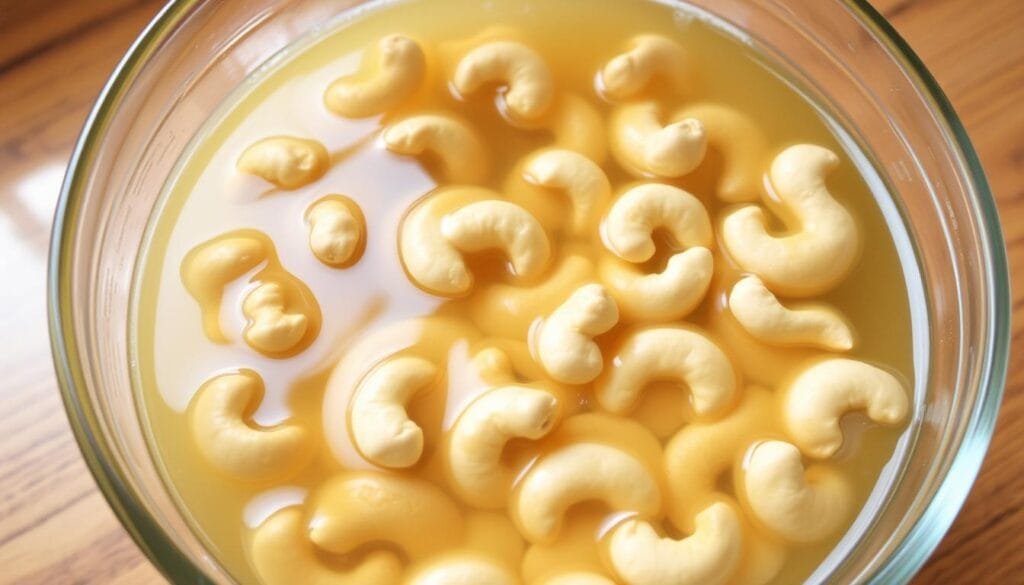
“Having the right tools makes all the difference in achieving the perfect vegan cheese texture and consistency.”
Step-by-Step Guide to Homemade Vegan Cheddar Cheese
Making your own vegan cheese recipe is simpler than you think! Just follow these easy steps to create a creamy, dairy-free cheddar cheese. Your taste buds will thank you.
- Begin by soaking 1 ½ cups of raw cashews in water for at least 4 hours or overnight. This softens them.
- After soaking, drain and rinse the cashews. Then, add them to a blender with ½ cup of water, 3 tablespoons of nutritional yeast, 1 tablespoon of lemon juice, 2 tablespoons of agar agar powder, ½ teaspoon of garlic powder, and 1 teaspoon of Himalayan pink salt.
- Blend everything on high speed until it’s smooth and creamy. Make sure to scrape down the sides as needed.
- Next, pour the blended mix into a saucepan. Cook over medium heat, stirring constantly, for about 10-15 minutes. Wait until it thickens and shines.
- When it’s thick, pour it into a dish or mold. Smooth the top and chill it in the fridge for 2-3 hours. This will make the cheese firm and set.
And that’s it! You’ve made your own vegan cheddar cheese! This cheese is great for many dishes, like sandwiches, snacks, cooking, and baking. Enjoy your homemade dairy-free cheese!
Tips for Achieving the Perfect Cheese Consistency
Making the perfect vegan cheese is all about a few key techniques. By controlling the temperature, you can get the right vegan cheese texture and dairy-free cheese consistency every time.
Temperature Control Techniques
Temperature is key to getting the right consistency. Keep the heat steady while cooking to let the ingredients thicken. If it gets too hot, it will be soft and gooey. If it’s too cold, it will be thin and watery.
After cooking, refrigerate the cheese to firm it up. The cold helps the agar-agar gel, making it firmer. For an even harder texture, freeze the cheese.
Storage Solutions
Proper storage keeps your vegan cheese perfect. Store it in an airtight container in the fridge for up to a week. Freezing it can extend enjoyment to up to 3 months.
Troubleshooting Common Issues
If your cheese is too soft, add more agar-agar. If it’s too firm, use less agar-agar. Adjusting the agar-agar ratio can help you get the perfect vegan cheese texture and dairy-free cheese consistency.
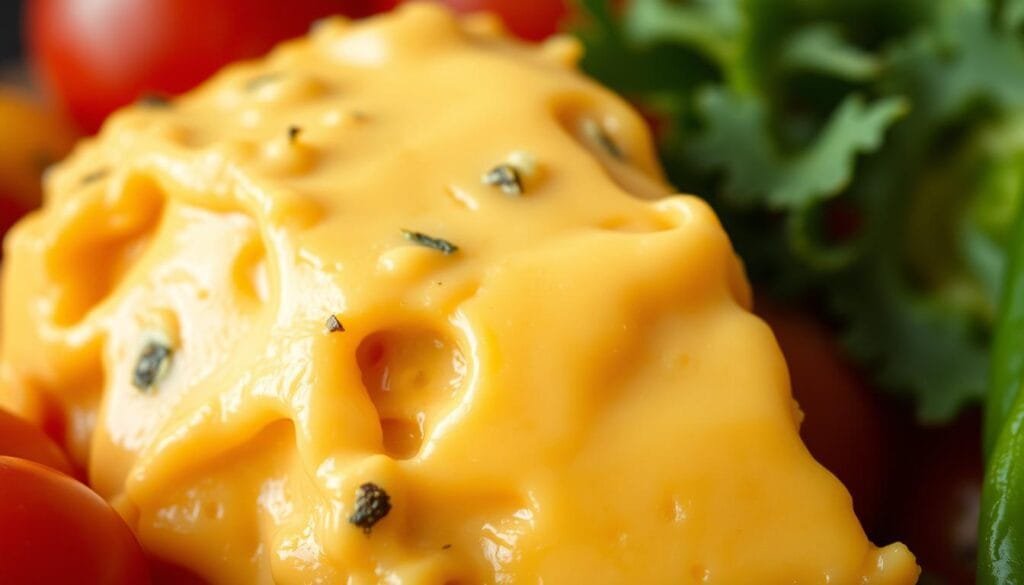
“Crafting vegan cheese with the perfect consistency takes a bit of practice, but the results are well worth the effort. With a little trial and error, you’ll be making cheese that rivals the real thing.”
Variations and Flavor Enhancements
Get creative in the kitchen and explore many vegan cheese flavors! There’s more than just cheddar when making your own dairy-free cheese. You can go from smoky to savory, herbal to tangy, with endless possibilities.
Try adding spices and seasonings to your cheese. Smoked paprika gives a smoky taste, while fresh herbs like rosemary or thyme add a nice aroma. For a sharp flavor, add more nutritional yeast or a bit of miso paste.
Want a smoked gouda taste? A few drops of liquid smoke can add a rich, woodsy smell. Let your taste guide you to find your favorite vegan cheese flavors and dairy-free cheese varieties.
- Smoked paprika for a smoky undertone
- Chopped fresh herbs like rosemary, thyme, or garlic for an aromatic touch
- Increased nutritional yeast or miso paste for a sharper flavor
- Liquid smoke for a smoked gouda-like aroma
Homemade vegan cheese is all about being customizable. Be your own culinary artist and create unique vegan cheese flavors. Your creations will amaze your friends and family.
Creative Ways to Use Your Vegan Cheese
Once you’ve made your own vegan cheddar cheese, you can use it in many ways. It’s perfect for sandwiches, grilled cheese, or charcuterie boards. This cheese is a must-have in your kitchen.
Sandwich and Snack Ideas
For a grilled cheese, just slice the cheese and place it between bread. Or, crumble it over a salad for a cheesy twist. Enjoy it with crackers, fruit, or on a vegan charcuterie board.
Cooking Applications
The meltable version of your vegan cheddar cheese is great in hot dishes. Sprinkle it on pizza or stir it into pasta for a gooey treat. It’s also good on baked potatoes, tacos, or casseroles.
With a bit of creativity, you’ll love using your vegan cheese. Impress your friends and family with your cooking skills!
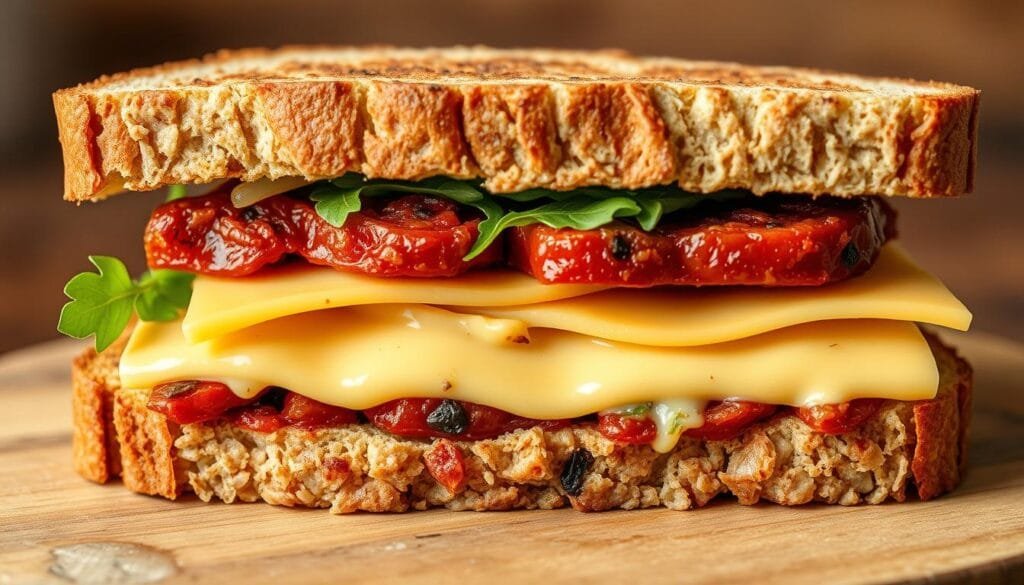
| Recipe Rating | Preparation Time | Chilling Time | Servings |
|---|---|---|---|
| 4.96 from 66 votes | 15 minutes | 3 hours | 6 |
Making vegan cheddar cheese takes under 20 minutes, not counting chilling. It makes about 8 servings and has a 5-star rating from 66 votes.
Storage Tips and Shelf Life
Storing your homemade vegan cheddar cheese right is important. It keeps the cheese fresh and tasty. Here are some tips for vegan cheese storage and dairy-free cheese preservation:
- Keep the cheese in an airtight container in the fridge for up to 5 days.
- Freeze it for up to 3 months. Slice or shred it first for easier portions.
- Use paper towels and plastic wrap to keep it dry and firm in the fridge.
The vegan cheddar cheese recipe ages in the fridge for 1-2 weeks. After that, you can store it for up to 5 days. For longer, freeze it in portions. Just remember, it might change a bit in texture after thawing.
| Cheese Type | Refrigerator Storage | Freezer Storage |
|---|---|---|
| Aged, Low-Moisture Cheeses | Several weeks | 12 months to 2 years |
| Soft or Fresh Cheeses | Up to 7 days | Not recommended |
| Vegan Cheddar Cheese | Up to 5 days after aging | Up to 3 months |
By using these vegan cheese storage and dairy-free cheese preservation tips, you can enjoy your vegan cheddar for days or months. Proper storage keeps the cheese’s flavor and texture at their best.

Health Benefits of Plant-Based Cheese
I’m always looking for healthy food options. Vegan cheese has really improved in recent years. It’s a great choice for those who want a plant-based diet.
Plant-based cheese is often cholesterol-free and has less saturated fat than dairy cheese. This is good for heart health and managing blood pressure or diabetes.
These cheeses are also good for people with lactose intolerance or milk allergies. They taste great and are full of nutrients. Ingredients like nutritional yeast add B-vitamins, and cashews offer healthy fats and protein.
| Nutrient | Dairy Cheese | Vegan Cheese |
|---|---|---|
| Cholesterol | High | None |
| Saturated Fat | High | Lower |
| Lactose | Present | Absent |
| Vitamins | Varies | Often Fortified |
| Protein | High | Moderate |
Some vegan cheese might have more sodium or processed ingredients. But, many brands like Treeline and Miyoko’s use whole, plant-based ingredients. They offer tasty, healthy options.
In summary, plant-based cheese is very healthy. It lets us enjoy our favorite flavors while eating nutritious, plant-based foods. It’s perfect for reducing saturated fat, avoiding dairy allergies, or trying new foods. Vegan cheese is a great addition to a healthy diet.
Recipe Modifications for Different Dietary Needs
Our homemade allergen-free vegan cheese meets various dietary needs. You can adjust it for nut allergies, soy-free diets, or to change the fat content. These simple changes make sure the gluten-free dairy-free cheese suits your needs.
Nut-Free Options
For those with nut allergies, swap cashews for coconut milk or other plant-based milks. This keeps the cheese smooth and creamy, without nuts.
Soy-Free Adaptation
Replace soy-based miso with chickpea miso for a soy-free version. It adds a savory umami flavor to your allergen-free vegan cheese.
Lower-Fat Modifications
To lower the fat, reduce or remove the oil. But remember, this might change the cheese’s texture and richness.
Our vegan cheddar recipe is flexible for any dietary need. Enjoy this tasty, allergen-free vegan cheese without guilt.
Expert Tips for Perfect Results Every Time
As a vegan cheese lover, I’ve picked up some key tips. First, use refined coconut oil to avoid a strong coconut taste. Also, measure your ingredients carefully. Small changes can greatly affect the cheese’s texture and consistency.
When cooking, simmer the cheese mix for the full time to get the right thickness. Adding miso paste at the end helps keep the probiotics. For a cheese that melts well, make sure to add tapioca starch as the recipe says.
By using these vegan cheese-making tips and dairy-free cheese tricks, you’ll make a delicious vegan cheddar cheese. Your family and friends will love it. Happy cheese-making!
